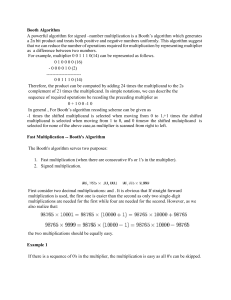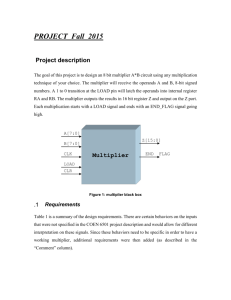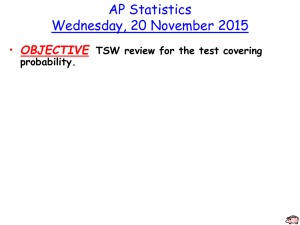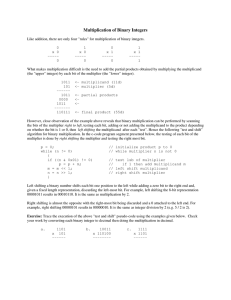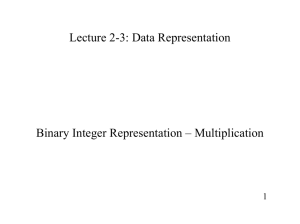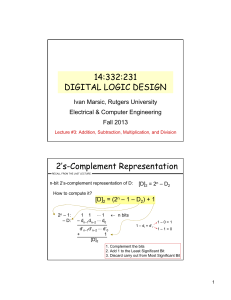6.111 Lecture # 12 Binary arithmetic: most operations are familiar
advertisement
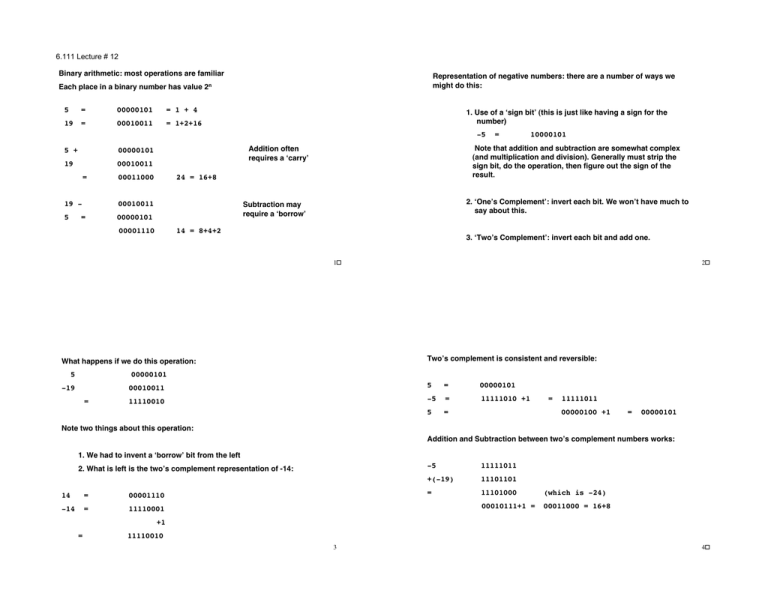
6.111 Lecture # 12 Binary arithmetic: most operations are familiar Representation of negative numbers: there are a number of ways we might do this: Each place in a binary number has value 2n 5 = 00000101 = 1 + 4 19 = 00010011 = 1+2+16 1. Use of a ‘sign bit’ (this is just like having a sign for the number) -5 5 + 00000101 19 00010011 = 19 - 00010011 5 00000101 = Addition often requires a ‘carry’ 00011000 24 = 16+8 10000101 2. ‘One’s Complement’: invert each bit. We won’t have much to say about this. Subtraction may require a ‘borrow’ 00001110 = Note that addition and subtraction are somewhat complex (and multiplication and division). Generally must strip the sign bit, do the operation, then figure out the sign of the result. 14 = 8+4+2 3. ‘Two’s Complement’: invert each bit and add one. 1 Two’s complement is consistent and reversible: What happens if we do this operation: 5 2 00000101 -19 = 00010011 5 = 00000101 11110010 -5 = 11111010 +1 5 = = 11111011 00000100 +1 = 00000101 Note two things about this operation: Addition and Subtraction between two’s complement numbers works: 1. We had to invent a ‘borrow’ bit from the left 2. What is left is the two’s complement representation of -14: 14 = 00001110 -14 = 11110001 -5 11111011 +(-19) 11101101 = 11101000 (which is -24) 00010111+1 = 00011000 = 16+8 +1 = 11110010 3 4 5.5 = 00000101.1 5.0 = 00000101.0 -5.0 = 11111010.1 + 1 = In many cases we want to extend a number: to employ more ‘binary places’ to represent a number. How do we do this extension? 19 = 00010011 X -5 = 11111011 = + = + 11111101.0 = + = To extend a number (represent with more places) without changing value: + 00010011 00010011 00111001 00010011 00011010001 00010011 10100001 is the negative of: 01011110+1 = 01011111 = 64+16+8+4+2+1=95 001000000001 00010011 If the number is: Extend to left Extend to right = Positive zeros zeros + 00010011 Negative ones zeros = 00100100100001 0010001100001 + 00010011 = 001001010100001 5 6 Now consider how we might do a simple multiplication Here is a hardware description of a multiplier 9 = X 13 = 00001101 = 00001001 This involves shifting the top number repeatedly to the left and adding it to the partial sum. This works well and requires a shift register as wide as the product as well as an accumulator for the partial and final product 00001001 + 00001001 = 0000101101 + 00001001 = 00001110101 If B[0] is 1, load (add # to accumulator), Shift Multiplicand left, Shift Multiplier right, Repeat until done (117) 7 8 9 = 00001001 X 13 = 00001101 Here is how it would work for negative numbers. We must extend the sign (put one’s in as we add places to the number An alternative is to shift the partial product to the right = 0000001001 -9 = + 00001001 X 13 = 00001101 = 00000101101 = 1111110111 + 00001001 = 00001110101 (same number shifted) + 11110111 = 11111010011 + = (-) 11110111 (remember sign extension) 11110111 111110001011 (-117) 000001110101 9 ‘sign extension’ consists of shifting ones into the MSB if it is a negative number. 10 Multiplication of Two’s Complement number by sign/magnitude number: This is one case that works fairly well -9 = 11110111 X 13 = 00001101 = 1111110111 + 11110111 = 11111010011 + 11110111 = (-) 111110001011 000001110101 1. Use the sign/magnitude number as the multiplier 2. If MSB is 1 (negative number), do the two’s complement thing on the multiplicand (remember sign extension) (-117) = 1+4+16+32+64=117 11 12 Many problems require multiplication. In fairness to what we have just said, there are The XOR complements each bit of the multiplicand if S=1 and the Carry in adds S (1 if S is set). If the multiplier is positive, the multiplicand is not complemented and zero is carried in. Choices: Table Lookup Each input is N bits wide ROM must store 2^N answers Fast but uses a lot of Silicon Log converter Convert to logs Add Antilog Converter Fast, maybe uses less Silicon Precision uncertain What to do about negative numbers? 13 14 It is Time for an example: so here is a physical system to control: More Multiplication Choices Control for a trolley car (Light Rail Vehicle) Control FORCE applied to wheels Speed command by driver (the 'Go lever') Accommodates car weight: The difference between commanded speed and actual car speed should be acceleration Add X input Y times Load Y into downcounter Add X each time while counting down Stop when counter gets to zero Real estate cheap Time uncertain (could be very long) And what about negative numbers? F = MA (required force is acceleration times car mass We will also use PI control: Integral part drives error to zero Proportional part gives stability Shift and Add This is the technique we have been using Technique you learned in elementary school Takes as many cycles as there are bits Uses a single register for multiplier and accumulator If care is taken with sign extension, can handle negative numbers consistently with others. 15 16 Uses feedback control As with any other design, we start with a high level block diagram: here are the inputs and outputs. Speed sensor and 'Go lever' are actual and required speed: through A/D Weight is measured by a load cell or air support system pressure Output is current command to motor/drive (which we assume works well) By measuring actual speed and feeding that back to the PI controller, we can drive speed error (exponentially) to zero. So in this example we will examine how to build the controller. We assume a highly ideal drive, in which drive force is directly proportional to commanded motor current. 17 18 Here is a possible Data Path for our PI Controller Integral approximated by a sum Here is a flow chart for our system: Timing establishes a fixed interval over which our control system does its thing. Speed error is difference between measured and commanded PI is just addition of the proportional and integrated signal. Integrated is added discrete signals here Ha: multiply will be interesting 19 20 Here is where the math gets done PI Controller Data Path (B) When done with the PI, we must multiply by weight. This fragment of data path handles that multiply as part of a shift and add routine. Note there is also a synchronizer here ALU Controls: 00 F = Invert A 01 F=A+1 10 F=A+B 11 F=A-B SR Controls 00 Hold 01 SHIFT R 10 CLEAR 11 LOAD 0 Rotate 1 Sign Extend SMUX 21 We could control this with one large FSM, but it seems reasonable to break the control down to several smaller (more easily developed and tested) FSM’s, which must then be coordinated Note: we don’t use all of these! 22 Here is my first guess at the ‘Main’ FSM that coordinates all. It starts other processes and waits for them to finish before going on. Note the TIC is produced by an FSM (a counter) that is NOT controlled by the main FSM. 23 24
